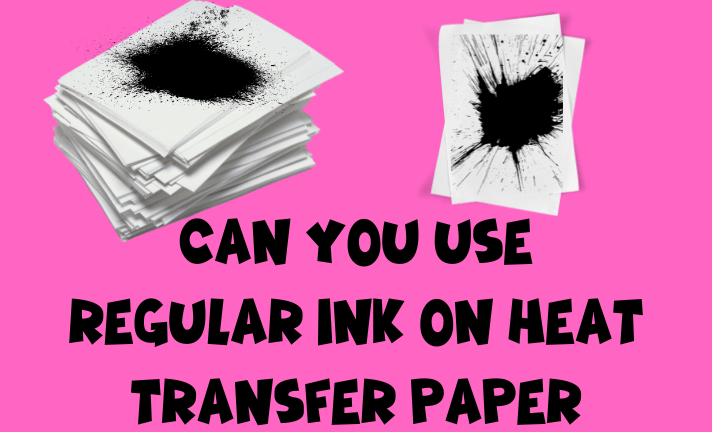The paper used for heat transfer is excellent. Clothing and other substrates can be customized without the use of a specialized printer. But here’s where the query comes up.
Can you use a standard printer and regular ink on heat transfer paper? Naturally, yes! Heat transfer paper can be used with standard inkjet printer ink, however, inkjet transfer paper is required. Now let’s explore the comprehensive guide.

Can Ordinary Ink Be Used on Heat Transfer Paper?
Standard inkjet printers utilize regular inkjet ink. Printing on clothing, mugs, and other materials is done with it. There are also various kinds of regular inkjet printers, including budget and high-end models.
Variations of this kind can impact durability and vibrancy. These helpful hints can help you create prints that are vivid and clear.
Make use of premium ink and a printer of superior quality. Of course, a cheap printer under $100 cannot produce colorful results. Only mediocre outcomes are possible. A printer under $300 and $400 to $500 may print more brilliant images than cheap printers and ink can.
· Use a high-end laptop or PC with higher graphics and adjust the printer settings to use crisp colors.
· Set the heat press or iron to a high temperature to transfer the prints.
Vibrant prints are guaranteed when using the best heat transfer paper. A hundred washings will not damage the prints. Good adhesive properties should be present in the paper. Additionally, it needs to work with the transfer and ink processes.
Which Ink Type Is Best for Heat Transfer Paper?
Use normal ink with a pigment base and heat transfer paper for prints that are bright and long-lasting. The explanation is that the little particles of pigment ink are intended to float in a liquid.
The microscopic pigment ink particles adhere to the fabric when heat is applied to the printed heat transfer paper. This produces prints that are robust and long-lasting. They peel and crack less frequently.
Pigment ink resists fading and water. This means that even after 40 washings, your prints will not likely fade in direct sunlight. Learn about the various varieties of ordinary ink and their characteristics by reading on.
What Are The Different Types Of Regular Ink?
However, because pigment ink resists fading and water, experts recommend using it instead. However, another common kind of ink is dye-based. It’s well known that dye ink produces more vivid colors. Wide-gamut gradients and smooth printing are other results.
However, dye-based ink is not resistant to fading or water, unlike pigment ink. Compared to prints made with pigment, the prints have a higher chance of fading or washing away.
Compared to dye-based ink, pigment ink is more resilient and lasts longer. It has a gritty texture and isn’t as colorful, though.
The kind of ink you choose to use with your prints is now entirely up to you. In addition, pigment ink costs more than dye ink, but the result is higher-quality prints.
A solid choice for high-quality color printing is dye-based ink. Pigment-based ink is a superior option if you need long-lasting printing that will not deteriorate over time.
Can I Use Any Ink For Heat Transfer?
No matter if it is DTF or DTG inkjet ink, no ink will function. For thermal transfers, however, regular inkjet or toner ink would suffice. You cannot use sublimation ink for heat transfer paper other than DTF and DTG. This ink is only meant to be used with sublimation transfer paper for printing. It is advised to use only standard inkjet or regular (pigment or dye) ink.
Is Special Ink Required for Heat Transfer Paper?
There’s no need to use specialized ink for vinyl or heat transfer paper. However, you need to set aside a certain amount of ink for your printer; regular ink will be enough. However, I advise using a high-end printer with a broad color range.
Because the Epson ET-8550 offers six color inks and a high page yield, I always enjoy using it. However, the fact that you’ll be receiving two extra ink bottles makes the ink more expensive. I create heat transfers with my ET-8550 using Epson original inks.
Is Ordinary Ink Capable of Withstanding High Heats During The Heat Transfer Process?
Indeed! Intense temperatures during heat transfer are tolerated by even ink. However, it’s vital to adhere to the heat transfer paper’s advice. Correct the pressure and temperature based on the aids of the paper. If not, the high temperature can offer erratic upshots.
Importance of Durability for Heat Transfer
When picking ink, strength for the heat transfer process is decisive to take into reason. The ink must be hardy to normal laundry, elongating, and general weathering. Dissimilar sublimation, heat transfer does not leak into the shirts or max. As a result, it doesn’t mix with the cloth. Therefore, you must work on the apparatus’s quality and suppleness.
Conclusion
To sum up, typical ink works healthy for any heat transfer file. You can use it to create your t-shirt printing firm or tailor your wear. However, you must make sure that your writing or charts are printed on the cloth. Overwhelming heat transfer paper and top dye ink are two of these.
Posted In: Heat Transfer
For More Information: printerguidepro.com
Related Post: Unlocking the Secrets of Heat Transfer Vinyl?
Best Regard { Rayyan Haider }

